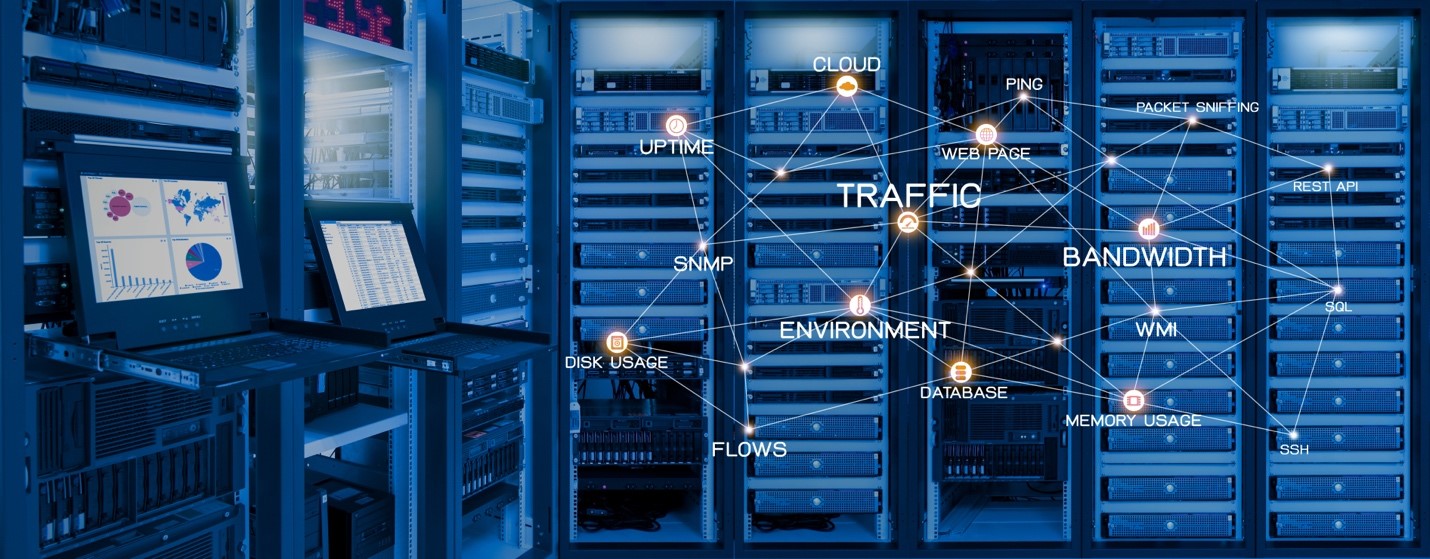Network monitoring is the continuous monitoring of a computer network's status and activities to ensure it is running smoothly and securely. It provides IT administrators with the information they need to see whether a network is running optimally and to identify performance issues, such as slow network connections or component failure, in real time. It can also help to detect security threats and regulatory non-compliance faster and provide early insight into future infrastructure needs.

How Does Network Monitoring Work?
Network monitoring can be performed in a variety of ways. It can be done manually, by having a technician or IT specialist review and analyze data collected from network devices, including routers, switches, firewalls, load balancers, and endpoints. However, with the improvement of monitoring technologies, it is increasingly done automatically, using specialized network monitoring solutions to collect and analyze data. Network monitoring tools are used to capture and analyze network traffic to detect network issues like anomalous behavior, performance bottlenecks, and security threats. Common tools used for network monitoring include packet sniffers, protocol analyzers, and network analyzers.
Network monitoring systems are operated using a network monitoring dashboard – a graphical interface that provides a comprehensive view of the performance of an organization's networks and IT infrastructure. It typically includes a collection of visualizations such as graphs, charts, and tables to help IT teams better monitor and manage their networks. The benefits of a network monitoring dashboard include improved visibility into the status of a network, tracking of performance metrics and trends, proactively identifying performance issues, and improved troubleshooting efficiency.
Overall, network monitoring is a critical part of any IT infrastructure as it helps to identify any potential problems quickly and prevent outages or other issues that could impair performance, availability, and security.
The Importance of Network Monitoring
The importance of network monitoring lies in its ability to provide continuous visibility into the status and security of the network, allowing IT teams to identify and address any issues quickly. This is critical for today’s ever-complex enterprise networks as organizations adopt digital technologies at speed and scale to provide valuable services to customers and enhance employee productivity.
As a result, network outages can lead to lost productivity and lost revenue and cost companies thousands of dollars in recovery costs. Poor network performance can lead to decreased efficiency and customer/user dissatisfaction, while network unavailability can prevent customers/users from accessing essential services. Security incidents can lead to data breaches, which can cause severe damage to a company’s reputation, lead to financial losses, and have serious legal implications.

Network monitoring thus helps organizations stay ahead of potential issues in highly dynamic IT environments and ensure that the network and its services are running smoothly and securely. Network monitoring also provides a better understanding of network resources, allowing IT teams to make informed decisions on how to optimize their networks.
Types of Network Monitoring
The four main types of network monitoring are Performance Monitoring, Availability Monitoring, Configuration Monitoring, and Security Monitoring.
Network Performance Monitoring
Network performance refers to how well a network is performing, in terms of its speed, efficiency, reliability, and bandwidth. It is monitored using network monitoring tools, which provide real-time insights into the health of the network. These tools use various network monitoring protocols such as Simple Network Management Protocol (SNMP) and Internet Control Message Protocol (ICMP) to monitor a variety of elements, such as latency, bandwidth, packet loss, and jitter.
Network performance monitoring methods include packet sniffing, packet loss analysis, latency analysis, throughput analysis, and bandwidth utilization monitoring. Packet sniffing involves capturing, analyzing, and decoding data packets as they travel across a network. Packet loss analysis is used to identify any packets that are lost during transmission and helps to identify any underlying problems with the network. Latency analysis measures the amount of time it takes for a packet to travel from one device to another. Throughput analysis measures the rate of data transfer between two devices, and bandwidth utilization monitoring tracks how much bandwidth is being used by each device.
Network Availability Monitoring
Network availability is the amount of uptime in a network system over a specific time interval, where uptime refers to the amount of time a network is fully operational and available for use by its users. It is generally expressed as a percentage, with high availability networks striving for five nines (99.999%) of uptime.
Network availability monitoring methods include ping tests, traceroute tests, response time tests, and throughput tests. Ping tests are used to measure the time it takes for a data packet to travel from one device to another. Traceroute tests measure the route that a packet takes as it traverses a network, as well as the amount of time it takes for the packet to reach its destination. Response time tests measure how quickly a server or device responds to a request. Throughput tests measure the rate of data transfer between two devices.
Network Configuration Monitoring
Network configuration monitoring is the process of managing and monitoring the settings of a computer network. It includes the configuration of hardware, software, and network settings. Network configuration monitoring tools are used to ensure that all devices on the network are correctly configured and that all network settings are in line with the organization’s policies.
Network configuration monitoring methods include device discovery, configuration auditing, and change tracking. Device discovery is used to identify all the devices that are connected to the network to ensure that all devices are scrutinized. Configuration auditing involves assessing the configuration of each device and ensuring that it is configured according to best practices. Change tracking is used to monitor any changes made to the configuration of each device, in order to ensure that the network remains secure and compliant.
Network Security Monitoring
Network security monitoring involves monitoring network traffic for suspicious patterns, scanning for vulnerabilities, monitoring user accounts and network access, and logging activity for analysis and reporting. Network security monitoring is done by collecting data from active network devices, such as endpoints, servers, firewalls, switches, load balancers, etc. This data is analyzed for suspicious patterns, vulnerabilities, and malicious activity. Network security monitoring tools typically provide a set of configurable dashboards or controls for orchestrating specific tests across the infrastructure under monitoring. Common methods used to monitor network security include Intrusion Detection Systems (IDS), Network Detection and Response (NDR), and Endpoint Detection and Response (EDR).
Network Monitoring with ForeNova
ForeNova NovaCommand is a Network Detection and Response (NDR) solution that continuously monitors and analyzes all network traffic to uncover network security threats and vulnerabilities. NovaCommand’s monitoring dashboard provides detailed information in graphical and tabular format to help network administrators identify cyber-attacks, vulnerabilities, and improper configurations on the network. This provides network administrators with the visibility to remediate issues promptly before they can escalate.

NovaMDR is a Managed Detection and Response service in which we provide 24x7 network monitoring from our Security Operations Center (SOC) using NovaCommand among other tools. Our security experts are responsible for investigating security alerts and containing any identified security incidents to prevent and minimize the impact on the business. Our experts also provide insights into network issues and misconfigurations discovered by our tools and experts, who will help you make the necessary adjustments to give you peace of mind.



.svg)
.svg)







